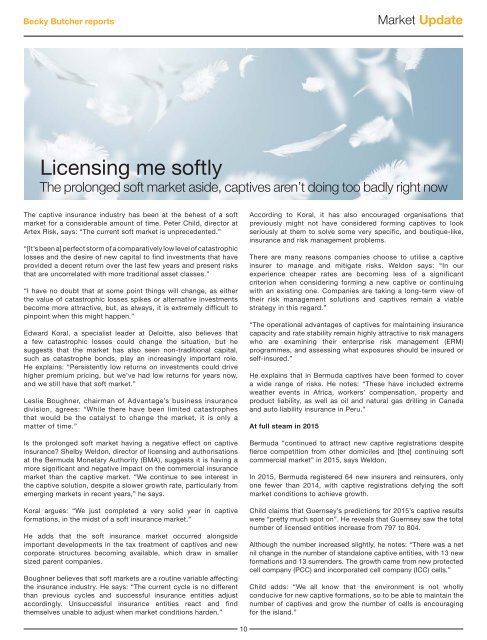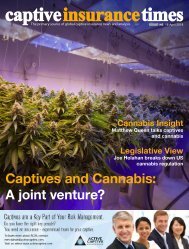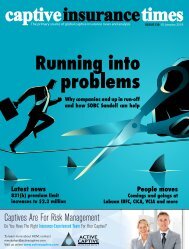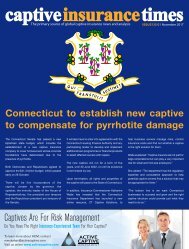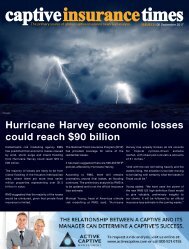Captive Insurance Times issue 91
his issue features interviews with executives from Strategic Risk Solutions, on the 831(b) tax election, and Cassatt Insurance Company, on the group mindset in healthcare.
his issue features interviews with executives from Strategic Risk Solutions, on the 831(b) tax election, and Cassatt Insurance Company, on the group mindset in healthcare.
You also want an ePaper? Increase the reach of your titles
YUMPU automatically turns print PDFs into web optimized ePapers that Google loves.
Becky Butcher reports<br />
Market Update<br />
Licensing me softly<br />
The prolonged soft market aside, captives aren’t doing too badly right now<br />
The captive insurance industry has been at the behest of a soft<br />
market for a considerable amount of time. Peter Child, director at<br />
Artex Risk, says: “The current soft market is unprecedented.”<br />
“[It’s been a] perfect storm of a comparatively low level of catastrophic<br />
losses and the desire of new capital to find investments that have<br />
provided a decent return over the last few years and present risks<br />
that are uncorrelated with more traditional asset classes.”<br />
“I have no doubt that at some point things will change, as either<br />
the value of catastrophic losses spikes or alternative investments<br />
become more attractive, but, as always, it is extremely difficult to<br />
pinpoint when this might happen.”<br />
Edward Koral, a specialist leader at Deloitte, also believes that<br />
a few catastrophic losses could change the situation, but he<br />
suggests that the market has also seen non-traditional capital,<br />
such as catastrophe bonds, play an increasingly important role.<br />
He explains: “Persistently low returns on investments could drive<br />
higher premium pricing, but we’ve had low returns for years now,<br />
and we still have that soft market.”<br />
Leslie Boughner, chairman of Advantage’s business insurance<br />
division, agrees: “While there have been limited catastrophes<br />
that would be the catalyst to change the market, it is only a<br />
matter of time.”<br />
Is the prolonged soft market having a negative effect on captive<br />
insurance? Shelby Weldon, director of licensing and authorisations<br />
at the Bermuda Monetary Authority (BMA), suggests it is having a<br />
more significant and negative impact on the commercial insurance<br />
market than the captive market. “We continue to see interest in<br />
the captive solution, despite a slower growth rate, particularly from<br />
emerging markets in recent years,” he says.<br />
Koral argues: “We just completed a very solid year in captive<br />
formations, in the midst of a soft insurance market.”<br />
He adds that the soft insurance market occurred alongside<br />
important developments in the tax treatment of captives and new<br />
corporate structures becoming available, which draw in smaller<br />
sized parent companies.<br />
Boughner believes that soft markets are a routine variable affecting<br />
the insurance industry. He says: “The current cycle is no different<br />
than previous cycles and successful insurance entities adjust<br />
accordingly. Unsuccessful insurance entities react and find<br />
themselves unable to adjust when market conditions harden.”<br />
According to Koral, it has also encouraged organisations that<br />
previously might not have considered forming captives to look<br />
seriously at them to solve some very specific, and boutique-like,<br />
insurance and risk management problems.<br />
There are many reasons companies choose to utilise a captive<br />
insurer to manage and mitigate risks. Weldon says: “In our<br />
experience cheaper rates are becoming less of a significant<br />
criterion when considering forming a new captive or continuing<br />
with an existing one. Companies are taking a long-term view of<br />
their risk management solutions and captives remain a viable<br />
strategy in this regard.”<br />
“The operational advantages of captives for maintaining insurance<br />
capacity and rate stability remain highly attractive to risk managers<br />
who are examining their enterprise risk management (ERM)<br />
programmes, and assessing what exposures should be insured or<br />
self-insured.”<br />
He explains that in Bermuda captives have been formed to cover<br />
a wide range of risks. He notes: “These have included extreme<br />
weather events in Africa, workers’ compensation, property and<br />
product liability, as well as oil and natural gas drilling in Canada<br />
and auto liability insurance in Peru.”<br />
At full steam in 2015<br />
Bermuda “continued to attract new captive registrations despite<br />
fierce competition from other domiciles and [the] continuing soft<br />
commercial market” in 2015, says Weldon.<br />
In 2015, Bermuda registered 64 new insurers and reinsurers, only<br />
one fewer than 2014, with captive registrations defying the soft<br />
market conditions to achieve growth.<br />
Child claims that Guernsey’s predictions for 2015’s captive results<br />
were “pretty much spot on”. He reveals that Guernsey saw the total<br />
number of licensed entities increase from 797 to 804.<br />
Although the number increased slightly, he notes: “There was a net<br />
nil change in the number of standalone captive entities, with 13 new<br />
formations and 13 surrenders. The growth came from new protected<br />
cell company (PCC) and incorporated cell company (ICC) cells.”<br />
Child adds: “We all know that the environment is not wholly<br />
conducive for new captive formations, so to be able to maintain the<br />
number of captives and grow the number of cells is encouraging<br />
for the island.”<br />
10


